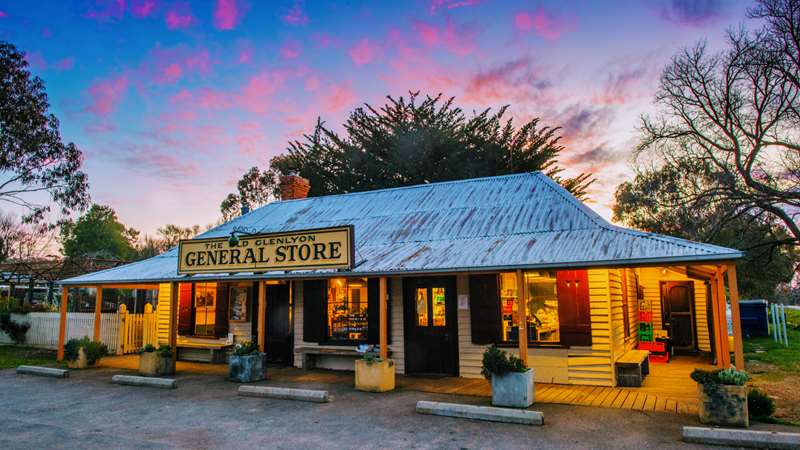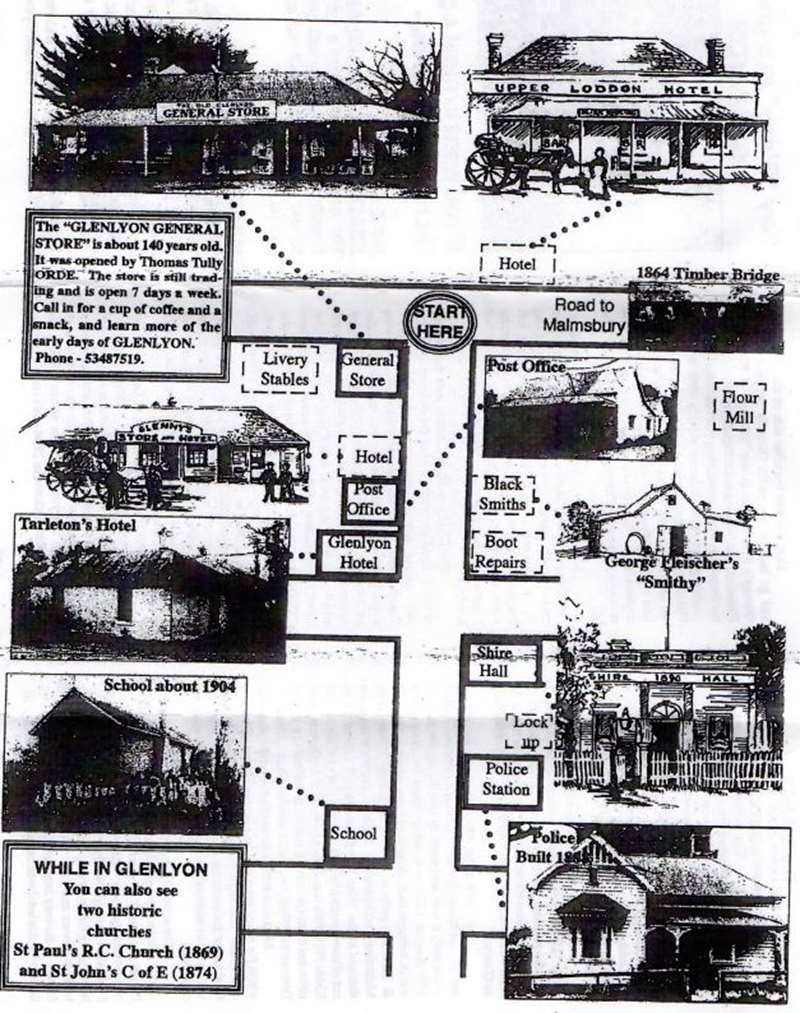Say G'day to a Ghost in Glenlyon


Say "G'day" to a ghost in Glenlyon.
If you want to meet a ghost, there are two rules -
RULE 1. GET OUT OF THE CAR AND WALK
The ghosts of Glenlyon's past are a friendly bunch, but they will not appear to just anyone. They will not appear to people sitting in cars.
RULE 2. CONCENTRATE AND IMAGINE
Rule 2 Is a little more difficult. It requires a little concentration and a lot of imagination. But it is not that hard to master because you will be standing at the actual spot where these real people and buildings stood over a century ago.
So, read the notes, follow the map, and say G'day to a ghost In Glenlyon.
Tour Map for Ghosts of Glenlyon

Your Itinerary
Your tour begins outside the General Store. If you close your eyes and concentrate and then, open your eyes and imagine. - The avenue of elm trees have disappeared and the bitumen road is now gravel. There are no power poles. The extensions added to the General Store have gone, as have the sheets of corrugated iron that cover the original wooden shingles on the roof. It is very quiet. There are no motor vehicles. The only sound is the rumble of loose planks on the wooden bridge over the Loddon river as a bullock wagon transporting stores from the railway goods yard at Malmsbury slowly makes its way across.
Just over the road to the North, is the site of the brick "Upper Loddon Hotel" where Mrs Eliza Rowling was the publican. A wooden verandah runs the length of this building and the word "Bar" is painted on two of the front windows. This hotel, built in 1861, is the oldest hotel in Glenlyon.
Now, walk about 50 yards up the main street and you are standing where "Glenny's Store and Hotel" stood until it was destroyed by fire during the night of 10th August 1938. A weather board building with a wooden shingle roof. Around mid-day each day, the Cobb & Co coach pulls in here on its 3 hour journey from Malmsbury to Daylesford. Cobb & Co's horse teams are changed at the "Half Way House Hotel" - about 3 kms out of town on the Malmsbury road, just over the crest of Kidds Hill. This coach carries bags of Melbourne mail collected from the railway station at Malmsbury for the Drummond, Glenlyon, and Daylesford Post Offices.
Next door is Miss Glenny's house (still standing) which for many years was the Glenlyon Post Office. The door to the "Post Office" part of the house is at the right hand end of the verandah and there is still a faint outline, next to the window, of the opening where people collected their mail.
The next building in the street is "The Glenlyon Hotel". Before the railway came to Daylesford in 1880. freight and passengers for the Daylesford goldfields were transported by rail to Malmsbury and then by road to Daylesford through Glenlyon. There were over a dozen hotels along this busy road to cater to the passing trade Of bullock drivers and foot travellers; but "The Glenlyon Hotel" is the only hotel building still standing. The first licence for this hotel was issued to Patrick Bolton in 1870.
Now cross to the other side of the Main Street and go back a few yards. Directly opposite to Miss Glenny's Post Office, is the "Smithy" of Mr George Fleischer. The building has collapsed and is now in ruins, but from where you are standing you could once hear the ringing sound of the hammer striking steel as George Fleischer swung his hammer and shaped the hot metal on the anvil. He brings the forge fire to a roaring white hot heat by bellows powered with a hand operated overhead wooden lever. When he plunges the hot metal into a tub of cooling water, hot fumes and clouds of steam fill the air.
A few yards up the street, is the corner site of Jack Murphy's Boot Repairs. In 1876 all Victorian toll roads were abolished. There were three toll gates operating on the Malmsbury to Daylesford road, and the toll keeper's cottages were sold by public auction. Mr Murphy senior bought one of these toll keeper's cottages and had it moved to this corner site as boot shop premises for his son Jack.
The Glenlyon Shire Council was the district centre of local government until the Shire of Glenlyon was merged with the Borough of Daylesford in 1966. The Hall, and Shire Administration offices, had a wooden picket fence along the street line, and there were stables for the councillors horses at the rear (where the CFA fire station is now). On the first and third Wednesday of each month, the building became a Court of the Midland District of the colony of Victoria, and court sessions were presided over by the District Police Magistrate, Mr John O'Meara and local Justices of the Peace. Petty offences, local disputes over unpaid debts, and school truancy were among matters dealt with by this court.
From the 1860's, until 1920 when the police station was closed, a mounted police constable was stationed in Glenlyon. The timber police residence was built in 1888 and is still standing but the adjoining lock-up and stables have now disappeared.
The last building in this tour of the main street is Glenlyon State School No 266. This building dates from about 1866 and predates both the churches and the Shire Hall. In the early days it was used for both church services and public meetings. The building has had several additions over the years and the window has been enlarged. The school closed in 1994 and is now a private residence.
Location
63 Barkly Street, Glenlyon 3461 Map











